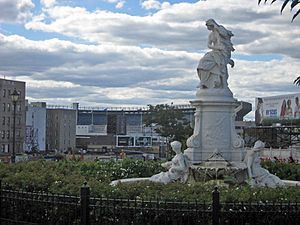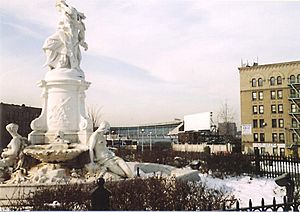Lorelei Fountain facts for kids
The Lorelei Fountain, also known as the Heinrich Heine Memorial, is a beautiful white marble fountain in the Concourse area of the Bronx, New York City. It's dedicated to the famous German poet and writer Heinrich Heine. Heine wrote a well-known poem about the Lorelei, a magical water spirit, like a mermaid, from a rock in St. Goarshausen, Germany.
This monument was first planned for Heine's hometown of Düsseldorf, Germany. However, because of strong feelings against Heine and his ideas, the monument couldn't be finished there for his 100th birthday in 1897. Instead, it was brought to the Bronx and officially shown to the public on July 8, 1899. The sculptor, Ernst Herter, was even there for the event.
Contents
What Does the Lorelei Fountain Look Like?
The Lorelei Fountain is located in Joyce Kilmer Park, which is near the Grand Concourse and 161st Street. It's also across from the Bronx County Courthouse.
At the top of the fountain, a life-sized figure of the Lorelei stands tall. Below her, in the fountain's bowl, three mermaids are seated. The base of the fountain has three decorative scrolls. On the front of the base, you can see a carved picture of Heine's face. Below his picture is his signature.
- To the left of Heine's picture, there's a figure that represents poetry. This figure is the only one that looks directly at Heine's portrait, showing a special connection. It also faces a rose, which means poetry and Heine are closely linked.
- To the right of Heine's picture, another figure represents satire. This figure turns its upper body towards Heine.
- At the back of the monument, a third figure shows melancholy or sadness. Her hair is long, and she looks down sadly.
Between these three figures, you'll see three dolphin heads. The Lorelei figure herself wears old-fashioned clothes, a necklace, and an embroidered jacket. Other carvings on the fountain show a Sphinx holding a young man and a humorous scene of someone killing a dragon. These carvings help connect the smaller figures to the Lorelei at the top.
How the Lorelei Fountain Came to Be
Early Plans in Germany
In 1887, a group in Düsseldorf, Germany, decided to create a monument for Heinrich Heine. They wanted it ready for his 100th birthday in 1897. Many people supported this idea, including the famous poet Paul Heyse. Even Empress Elisabeth of Austria-Hungary, who admired Heine, joined the committee. She even gave a large sum of money (50,000 marks) for the monument, but she wanted the sculptor Ernst Herter to build it.
In 1888, the Düsseldorf City Council voted on building the monument. The vote was tied, showing how divided people were about Heine. Herter made several designs. The Empress liked a design with Heine sitting, but Düsseldorf preferred the Lorelei Fountain design we see today.
However, not everyone in Germany wanted a Heine monument. Some people published writings against him, and newspapers also criticized him. By 1889, the Empress stopped her support, and not enough money was raised from the public. The project faced many delays.
Finding a Home in New York City
After Düsseldorf officially rejected the monument in 1893, other German cities like Mainz and Frankfurt considered taking it. But these plans also failed due to strong opposition.
So, people started looking outside Germany. A German singing group in New York City called the Arion Society became interested in 1893. The sculptor, Herter, began working on plans for a New York location.
However, even in New York, finding a spot for the monument wasn't easy. The Arion Society wanted to put it at Grand Army Plaza near Central Park. But this idea faced opposition from some people who thought the design was "dry" or not special enough. The New York City Department of Parks and Recreation also asked Düsseldorf if they rejected the monument for artistic reasons, not just political ones. The New York Times newspaper even called it "academic mediocrity."
Because of this opposition, other places in New York City, like Brooklyn or Queens, or even Baltimore, Maryland, were considered. Finally, in March 1896, a state art commission decided the monument should be placed in the Bronx.
The Lorelei Fountain was officially unveiled on July 8, 1899, at East 164th Street and Grand Concourse in the Bronx. Thousands of people attended the ceremony, and Ernst Herter, the sculptor, was there to see it.
Challenges and Restoration


From the very beginning, the Lorelei Fountain faced problems with damage and vandalism. Even with police guarding it, parts of the mermaids' arms were cut off in 1900. In 1940, the fountain was moved to a different part of the park and partly fixed.
Over the years, the vandalism continued. In the 1970s, it was considered one of the most damaged statues in New York City. The heads of the female figures were cut off again, and the monument was covered in graffiti.
In 1987, plans were made to fully restore the fountain and move it back closer to its original spot. The Municipal Art Society of New York started a program to fix damaged monuments. The restoration was expensive, costing hundreds of thousands of dollars, but private donations helped raise the money.
Finally, on July 8, 1999, exactly 100 years after its first unveiling, the Lorelei Fountain was reopened. It was placed at East 161st Street and the Grand Concourse, just a few blocks from where it first stood.
Images for kids





